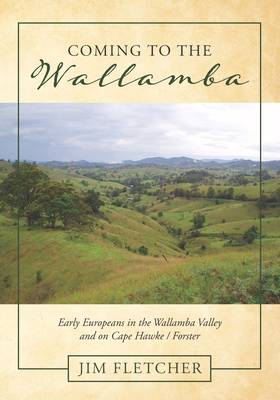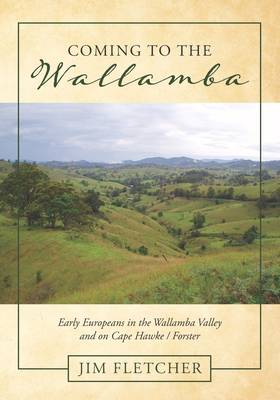
Je cadeautjes zeker op tijd in huis hebben voor de feestdagen? Kom langs in onze winkels en vind het perfecte geschenk!
- Afhalen na 1 uur in een winkel met voorraad
- Gratis thuislevering in België vanaf € 30
- Ruim aanbod met 7 miljoen producten
Je cadeautjes zeker op tijd in huis hebben voor de feestdagen? Kom langs in onze winkels en vind het perfecte geschenk!
- Afhalen na 1 uur in een winkel met voorraad
- Gratis thuislevering in België vanaf € 30
- Ruim aanbod met 7 miljoen producten
Zoeken
Coming to the Wallamba
Early Europeans in the Wallamba Valley and on Cape Hawke/Forster
Jim Fletcher
Paperback | Engels
€ 29,45
+ 58 punten
Omschrijving
Coming to the Wallamba is not structured along the themes commonly used in local histories, such as the first inhabitants, early settlers, farming, grazing, floods and droughts, road and river transport, religion, post offices, schools, and so on, although these topics are treated along the way. Instead the book tells the stories of the first Europeans who came to the Wallamba Valley or Cape Hawke (later Forster) on the mid-north coast of New South Wales up to 1870. Families are the main themes and it is through them that the history unfolds. Each family is traced from its origin overseas or in the colony and how each came to be working or living in the Wallamba Valley or on Cape Hawke, so that the where, when and why they were in the colony is just the start of their journey. What land they bought or selected and how they fared is also described in order to let readers get to know each family and to realise how fascinating most of them were.Those described in the book are a strange mix of a few well educated university graduates to those who had enough schooling to read and write, to those who could not sign their name other than with a cross. There were goodhearted folk as well as cranky, irascible ones, but mostly ones that we can identify as people we could get on well with. Many had a convict background or had been convicts themselves and several disguised this fact causing confusion among their descendants. Their convict background was no bar to finding a spouse. There was also a small amount of intermarriage between European men and Aboriginal women and there are many descendants of those who came to the Wallamba or Forster who have an Aboriginal or a convict ancestry. Some have both.Some of the people dealt with in detail are: Henry Alway & Mary Buttsworth; Joseph Basham & Harriet Colburn; James Bowers & Jane Collins; John Breckenridge; Henry Carmichael & Nancy McClymont; Allen Cheers; Joseph Clerkin & Harriet Wrench; Joseph Croker & Mary Boyle; Magnus Cromarty & Christina McIntosh; John Dargaville & Isabella Greenshields; Thomas Dunn & Mary Franklin; James Everingham & Sarah Rogers; Joseph Franklin & Johanna Ryan; George Godwin & Mary Jones; George Greenaway & Charlotte Blackburn; Richard Hardy & Suvina Hill; Owen Matheson & Catherine Byrne; James & Margaret McCann; William McCay, Frances Mann & Mary Schubert; William McClymont, Sarah Carter & Annie Butler; (Alexander) John McGilvray; Murdoch McIntosh & Elizabeth Godwin; Donald McKinnon & Anne Cameron, James Mead & Ellen Durant; (Robert) James Nixon & Sarah Ann Buttsworth; William Norcott & Annie Ewbank, George Riley & Margaret Riley, Robert Salter & Catherine Matheson; Charles Garrett Smith & Alice Dignam; James Smith & Hughena McKay, George Spooner & Caroline Bareham; William Startin & Charlotte Clamtree. It also deals with several people who lived in Taree, including Dr Frederick Calov, Horace Dean, Henry Flett, Rev. William Hawkins, George Rowley, and William and Delamore Wynter.Until 1861 only one European had bought land and settled in the Wallamba Valley and no one on Cape Hawke (Forster), and had it not been for the introduction of the 'free selection' act in the early 1860s, it is unlikely that many Europeans would have lived in either area for years to come. Most, if not all, of the early selectors on the Wallamba and Cape Hawke in the 1860s and 1870s lived frugally and were accurately described as poor. Their land was not only a place to live, it was also a place to work and a place that mostly produced enough for them to live on. It was a lifestyle and a business that they could pass on to their children. Their assets consisted of the land they had originally selected and later added to, their houses, farm equipment and stock.
Specificaties
Betrokkenen
- Auteur(s):
- Uitgeverij:
Inhoud
- Aantal bladzijden:
- 410
- Taal:
- Engels
Eigenschappen
- Productcode (EAN):
- 9781922368164
- Verschijningsdatum:
- 14/01/2020
- Uitvoering:
- Paperback
- Formaat:
- Trade paperback (VS)
- Afmetingen:
- 178 mm x 254 mm
- Gewicht:
- 707 g

Alleen bij Standaard Boekhandel
+ 58 punten op je klantenkaart van Standaard Boekhandel
Beoordelingen
We publiceren alleen reviews die voldoen aan de voorwaarden voor reviews. Bekijk onze voorwaarden voor reviews.









